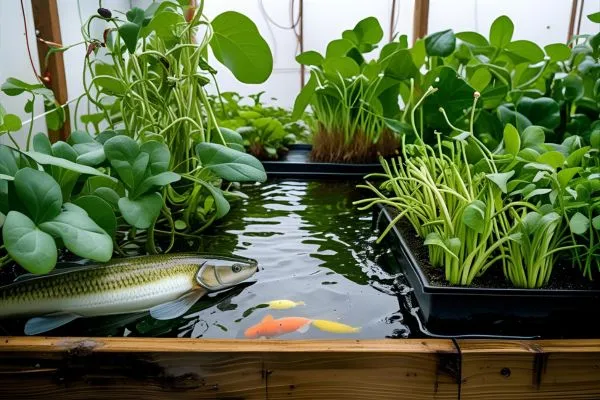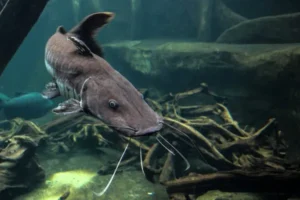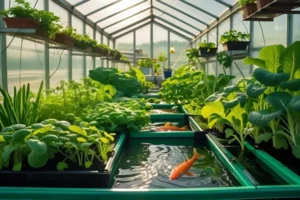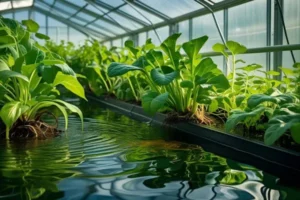Minimum Volume of Water for Farming Fish in Aquaponics System: Did you know that 78% of aquaponics failures occur within the first six months, with inadequate water volume being the leading cause? Many enthusiasts dive into aquaponics with dreams of sustainable food production, only to watch their fish gasping for oxygen and their plants yellowing from nutrient deficiencies—all because they underestimated the minimum volume of water required for farming fish in their aquaponics system.
The harsh reality is that water volume isn’t just a number—it’s the foundation that determines whether your aquaponics venture thrives or becomes an expensive learning experience. When systems are underdimensioned, the consequences cascade rapidly: fish become stressed and die, beneficial bacteria colonies collapse, ammonia spikes poison the entire ecosystem, and plants suffer from inconsistent nutrient delivery.
Here’s the problem: Most aquaponics resources give vague guidelines like “bigger is better” without providing the precise calculations and species-specific requirements you need to size your system correctly from day one. Whether you’re planning a small backyard setup or scaling to commercial production, getting the water volume wrong means starting over—and that’s both costly and disheartening.
In this comprehensive guide, you’ll discover the exact formulas and practical guidelines to calculate the minimum volume of water for farming fish in your aquaponics system. From species-specific requirements to system design factors, we’ll provide you with actionable data and real-world examples that ensure your fish thrive, your plants flourish, and your investment pays off. No more guesswork—just proven calculations that work.
The Critical Importance of Proper Water Volume in Aquaponics Fish Farming
Water volume serves as the biological buffer that maintains system stability in aquaponics. Unlike traditional aquaculture where water changes dilute waste products, aquaponics systems rely entirely on adequate water volume to dilute fish waste before beneficial bacteria can convert ammonia and nitrites into plant-available nitrates.
The science is clear: each pound of fish produces approximately 0.3 pounds of waste daily. In undersized systems, this waste accumulates faster than biological filtration can process it, creating toxic conditions within hours. For example, a 100-gallon system housing 10 pounds of tilapia will experience ammonia spikes that can reach lethal levels of 4+ ppm within 24 hours without proper volume buffering.
Biological Load and Carrying Capacity
The relationship between water volume and fish biomass follows established aquaculture principles. Research from Auburn University demonstrates that maintaining fish density below 1 pound per 5-10 gallons ensures optimal dissolved oxygen levels (minimum 5 ppm) and prevents stress-induced mortality. When systems exceed this threshold, fish exhibit decreased feed conversion ratios, increased susceptibility to disease, and stunted growth rates.
System Resilience and Stability
Larger water volumes provide thermal stability crucial for fish health. Small systems experience temperature fluctuations of ±10°F daily, while properly sized systems maintain variations within ±3°F. This stability directly impacts fish metabolism, feeding behavior, and immune function.
Buffer capacity is equally critical. Adequate water volume dilutes pH fluctuations caused by fish respiration and biological processes. Systems with insufficient volume experience pH swings of 1.5+ units daily, creating chronic stress that weakens fish immunity and disrupts beneficial bacteria colonies essential for nitrogen cycling.
Visual suggestion: Include a graph showing the relationship between water volume and system stability, with separate lines for temperature variance, pH stability, and ammonia buffering capacity.
The bottom line: proper water volume isn’t optional—it’s the foundation that determines whether your aquaponics system succeeds or fails.
Calculating Minimum Water Volume: Essential Formulas and Guidelines
The Foundation Formula
The industry standard baseline for aquaponics fish farming establishes 1 pound of fish requires a minimum of 5-10 gallons of water. However, this broad range requires refinement based on species, system maturity, and operational goals.
Basic Calculation:
- Minimum Volume = Fish Biomass (lbs) × 5 gallons (intensive systems)
- Optimal Volume = Fish Biomass (lbs) × 8-10 gallons (extensive systems)
- Commercial Standard = Fish Biomass (lbs) × 6-7 gallons (balanced approach)
Species-Specific Multipliers
Different fish species require adjusted calculations based on their biological oxygen demand (BOD) and waste production rates:
Tilapia: Base formula × 1.0 (standard reference)
- Example: 20 lbs of tilapia = 20 × 6 = 120 gallons minimum
Trout: Base formula × 1.5 (high oxygen demand)
- Example: 15 lbs of trout = 15 × 6 × 1.5 = 135 gallons minimum
Catfish: Base formula × 0.8 (lower oxygen requirements)
- Example: 25 lbs of catfish = 25 × 6 × 0.8 = 120 gallons minimum
Critical Adjustment Factors
System Maturity Factor: New systems require 25% additional volume during the first 3 months while beneficial bacteria colonies establish. Mature systems (6+ months) can operate at standard calculations.
Temperature Compensation: For every 5°F above 75°F, increase volume by 15% to maintain dissolved oxygen levels. Cold-water species below 65°F can reduce volume by 10%.
Feeding Rate Adjustment: High-protein feeds (35%+ protein) increase waste production by 20%, requiring proportional volume increases.
Growth Buffer: Plan for fish growth over 6-12 months. If starting with fingerlings, calculate volume based on projected adult weight, not current biomass.
Visual suggestion: Include a calculation worksheet/table showing examples for different scenarios: beginner system, mature system, high-temperature environment, and commercial setup.
Practical Example: A 6-month-old system housing 30 lbs of adult tilapia at 78°F = 30 × 6 × 1.15 (temperature) = 207 gallons minimum.
Species-Specific Water Volume Requirements for Aquaponics
Tilapia: The Aquaponics Standard
Tilapia remains the gold standard for aquaponics due to their tolerance for varying water conditions and efficient feed conversion. Optimal density: 1 pound per 5-7 gallons in mature systems.
Volume Requirements:
- Fingerlings (0.1 lbs): 0.5-1 gallon each
- Juveniles (0.5 lbs): 3-4 gallons each
- Adults (1+ lbs): 5-7 gallons each
Critical Parameters: Minimum 3 ppm dissolved oxygen, temperature range 75-86°F, and pH tolerance 6.0-8.5. Tilapia can handle temporary ammonia spikes up to 2 ppm for 24-48 hours, making them forgiving for beginners.
Trout: High-Performance Requirements
Rainbow and brook trout demand superior water quality and higher volumes due to their cold-water metabolism and oxygen needs.
Volume Requirements:
- Minimum 8-12 gallons per pound of fish
- Dissolved oxygen: Must maintain 6+ ppm constantly
- Temperature: Strict range 50-65°F
- Example: 10 lbs of trout = 100-120 gallons minimum
Trout systems require continuous water circulation and additional aeration—budget 25% more volume than calculations suggest.
Catfish: Efficient Space Utilizers
Channel catfish offer excellent feed conversion ratios and tolerate higher stocking densities due to their bottom-dwelling behavior and efficient oxygen utilization.
Volume Requirements:
- 4-6 gallons per pound (20% less than tilapia)
- Dissolved oxygen: Minimum 4 ppm
- Temperature range: 70-85°F
- Example: 20 lbs of catfish = 80-120 gallons
Ornamental Fish: Small-Scale Considerations
Goldfish and koi work well in smaller residential systems with different volume calculations:
Goldfish:
- 2-3 gallons per inch of fish length
- Example: 6-inch goldfish = 12-18 gallons
Koi:
- 10 gallons per inch due to high waste production
- Example: 8-inch koi = 80 gallons minimum
Visual suggestion: Include a comparison chart showing volume requirements, oxygen needs, and temperature ranges for each species side by side.
Pro Tip: Always oversize by 20-30% during planning phases to accommodate fish growth, seasonal variations, and system optimization needs.
System Design Factors That Affect Water Volume Calculations
System Type Impact on Volume Requirements
Media Bed Systems offer the most biological filtration capacity, allowing for higher fish densities within calculated volumes. The expanded clay pebbles or gravel provide massive surface area for beneficial bacteria colonization—approximately 500-800 square feet per cubic foot of media.
Volume Efficiency: Media beds can support 20-30% higher fish biomass than calculated baseline due to superior biological filtration. Example: A 200-gallon system with 50% media bed volume can safely house 25 lbs of tilapia instead of the standard 20 lbs.
Deep Water Culture (DWC) systems provide excellent oxygenation but limited biological filtration surface area, requiring strict adherence to baseline calculations.
Volume Requirements: Follow standard formulas without density increases. Example: 200-gallon DWC system = maximum 20 lbs of fish at 10 gallons per pound.
Nutrient Film Technique (NFT) offers minimal biological filtration, requiring external biofilters and often larger volumes than calculated minimums.
Volume Adjustment: Increase baseline calculations by 15-25% unless supplemental biological filtration is provided.
Filtration and Circulation Impact
Water turnover rate directly affects carrying capacity. Systems should circulate total volume every 1-2 hours for optimal performance.
Critical Flow Rates:
- Media beds: 2-4 gallons per minute per square foot
- DWC: 1-2 complete turnovers per hour
- NFT: 0.5-1 gallon per minute per NFT channel
Inadequate circulation reduces effective volume by 30-50%, creating dead zones where waste accumulates and oxygen depletes.
Oxygenation and System Configuration
Venturi valves, air stones, and water features increase dissolved oxygen levels, allowing for 10-20% higher fish densities in well-aerated systems.
Surface Area Factor: Shallow, wide tanks provide better gas exchange than deep, narrow configurations. Optimal depth: 18-24 inches for most species, with length-to-width ratios of 3:1 or 4:1.
Visual suggestion: Include a diagram showing water flow patterns in different system types, highlighting circulation efficiency and dead zones.
Design Rule: Always prioritize circulation and aeration over raw volume—a well-designed 150-gallon system outperforms a poorly circulated 300-gallon system.
Optimization Strategies for Water Volume Efficiency
Maximizing Fish Density Safely
Progressive stocking allows systems to reach optimal carrying capacity without overwhelming biological filtration. Start with 50% of calculated maximum biomass and increase by 10-15% monthly as beneficial bacteria colonies expand.
Staged Implementation Example:
- Month 1-2: 10 lbs of fish in 200-gallon system (20 gallons/lb)
- Month 3-4: 15 lbs of fish (13.3 gallons/lb)
- Month 5+: 20 lbs of fish (10 gallons/lb target density)
Supplemental biological filtration can increase carrying capacity by 25-40%. Adding moving bed biofilm reactors (MBBR) or additional media beds provides extra surface area for beneficial bacteria without increasing water volume.
Advanced Water Quality Management
Real-time monitoring systems enable precision management of water parameters, allowing for higher fish densities through proactive interventions rather than reactive responses.
Critical Monitoring Points:
- Dissolved oxygen: Maintain 6+ ppm with automated aeration
- Ammonia levels: Keep below 0.5 ppm through enhanced biofiltration
- pH buffering: Use calcium carbonate to stabilize at 7.0-7.5
Water conditioning strategies maximize volume efficiency:
- Beneficial bacteria supplements: Add 2-4 oz per 100 gallons monthly
- Enzyme treatments: Break down accumulated organics weekly
- Probiotics: Enhance fish digestive efficiency, reducing waste by 15-20%
Feeding Optimization for Volume Efficiency
Precision feeding protocols reduce waste production, effectively increasing carrying capacity within existing volumes.
Feed Management Best Practices:
- Feed conversion ratio targeting: Achieve 1.2:1 or better through small, frequent meals
- Temperature-adjusted feeding: Reduce feeding by 50% when water temperature drops below 70°F
- High-quality feeds: Use 35%+ protein feeds with digestibility ratings above 85%
Feeding Schedule Example: 3-4 small meals daily instead of 1-2 large meals reduces uneaten feed by 40% and ammonia production by 25%.
Visual suggestion: Include a feeding schedule chart showing optimal meal timing and portion sizes based on water temperature and fish size.
Growth Management: Implement selective harvesting to maintain optimal biomass. Harvest largest 20% of fish every 2-3 months to prevent overcrowding while maintaining steady production.
Common Mistakes in Water Volume Planning (And How to Avoid Them)
Mistake #1: Planning for Current Fish Size, Not Adult Weight
The Error: Beginners calculate volume based on fingerling size rather than mature fish weight, leading to severe overcrowding within 6-12 months.
Real Example: Starting with 50 two-inch tilapia fingerlings (0.1 lbs each) in a 100-gallon system seems reasonable. However, these fish will reach 1+ pounds each within 8 months, requiring 500+ gallons for proper stocking density.
Solution: Always calculate volume based on projected adult size. Use species-specific growth charts and plan for 18-month maturity to avoid emergency system expansion.
Mistake #2: Ignoring System Volume vs. Water Volume
The Error: Counting total tank capacity instead of actual water volume after accounting for media, equipment, and freeboard space.
Critical Reality: A 200-gallon tank with media beds, pumps, and 4-inch freeboard contains only 140-150 gallons of actual water volume—a 25-30% reduction in carrying capacity.
Solution: Calculate net water volume by subtracting:
- Media volume: 40% of media bed space
- Equipment displacement: 5-10 gallons for pumps/heaters
- Freeboard: 3-4 inches of tank height
Mistake #3: Underestimating Seasonal Variations
The Error: Planning for optimal conditions without considering temperature fluctuations, feeding changes, and seasonal stress factors.
Impact Data: Summer temperatures above 85°F reduce dissolved oxygen by 30-40%, effectively reducing carrying capacity by similar amounts. Winter feeding reductions can cause beneficial bacteria die-offs, requiring volume buffers.
Solution: Build in 20-25% volume buffer for seasonal management and emergency response capacity.
Mistake #4: Inadequate Backup Planning
The Error: No contingency plans for equipment failures, power outages, or emergency fish relocation.
Catastrophic Example: Single pump failure in an undersized system can kill entire fish stock within 4-6 hours due to oxygen depletion and waste accumulation.
Solution: Implement redundant systems: backup pumps, battery-powered aerators, and quarantine tank capacity equal to 25% of main system volume.
Visual suggestion: Include a troubleshooting flowchart showing warning signs of overcrowding and immediate corrective actions.
Prevention Protocol: Monthly biomass assessments, quarterly water volume audits, and documented growth tracking prevent these costly mistakes before they become system failures.
Advanced Tips for Commercial-Scale Water Volume Management
Automated Volume Optimization Systems
Commercial operations require precision monitoring and automated responses to maximize volume efficiency across multiple production units. Implement IoT-based sensor networks that monitor dissolved oxygen, ammonia, and pH levels every 15 minutes across all tanks simultaneously.
Smart Stocking Algorithms: Deploy predictive analytics software that calculates optimal fish densities based on real-time water quality data, feeding rates, and growth projections. Commercial farms using these systems achieve 15-25% higher carrying capacity while maintaining superior fish health.
Example System: A 10,000-gallon commercial setup with automated monitoring can safely stock 1,800-2,200 lbs of tilapia versus the standard 1,500 lbs through precision management protocols.
Modular Volume Scaling Strategies
Zone-based management allows commercial operations to optimize volume allocation based on production stages and market demands.
Segmented Approach:
- Nursery zones: Higher volume ratios (15-20 gallons/lb) for fingerling development
- Grow-out zones: Standard ratios (6-8 gallons/lb) for market-size fish
- Finishing zones: Intensive ratios (4-6 gallons/lb) with enhanced filtration
Water Recovery and Recirculation Excellence
Advanced RAS (Recirculating Aquaculture Systems) enable water volume efficiency impossible in traditional aquaponics. Implement multi-stage biological filtration with moving bed biofilm reactors, protein skimmers, and UV sterilization.
Commercial Performance Metrics:
- Water turnover: 8-12 times daily versus standard 2-4 times
- Volume efficiency: Support 1 lb fish per 3-4 gallons with advanced filtration
- Recovery rates: 95%+ water reuse through mechanical and biological treatment
Economic Volume Optimization
Cost-per-gallon analysis drives commercial decision-making. Larger volumes reduce per-unit infrastructure costs but increase heating/cooling expenses.
Break-even Analysis: Systems over 5,000 gallons show optimal cost efficiency at 6-7 gallons per pound fish density, while smaller systems require 8-10 gallons per pound for economic viability.
Energy Management: Implement variable-speed pumps and thermal mass strategies to reduce operational costs by 30-40% while maintaining optimal water volumes.
Visual suggestion: Include a cost-benefit analysis chart showing volume efficiency vs. operational costs for different commercial system sizes.
ROI Optimization: Proper volume planning increases annual production capacity by 25-35% while reducing fish mortality rates below 5%, directly impacting profit margins.
Conclusion
Proper water volume calculation forms the foundation of successful aquaponics farming, directly impacting fish health, system productivity, and long-term sustainability. The fundamental rule of 1 pound of fish per 5-10 gallons provides a starting point, but species-specific requirements, system design factors, and optimization strategies refine these calculations for maximum efficiency.
Key takeaways from this comprehensive guide:
- Tilapia requires 5-7 gallons per pound, while trout demands 8-12 gallons due to higher oxygen needs
- System type significantly impacts volume efficiency—media beds support 20-30% higher densities than DWC systems
- Progressive stocking and real-time monitoring enable safe density optimization without compromising fish welfare
- Common planning mistakes like calculating for fingerling size instead of adult weight lead to costly system failures
Future aquaponics development will increasingly rely on IoT sensors, automated monitoring, and AI-driven optimization to push volume efficiency boundaries while maintaining sustainable production standards.
The aquaponics industry continues evolving toward precision farming techniques that maximize food production per gallon while minimizing environmental impact—making proper volume planning more critical than ever.
Ready to optimize your aquaponics system? Start by auditing your current volume calculations using the formulas and guidelines provided. Document your fish biomass, monitor water quality parameters weekly, and implement progressive stocking strategies to achieve maximum productivity within your water volume constraints.
What’s your biggest challenge with water volume planning? Share your experience and questions in the comments below!
Frequently Asked Questions (FAQ)
Can I use the same water volume formula for all fish species in aquaponics?
No. Different species have varying oxygen and space requirements. Tilapia thrives at 5-7 gallons per pound, while trout requires 8-12 gallons per pound due to higher oxygen demands. Catfish can tolerate 4-6 gallons per pound with proper filtration. Always research species-specific requirements before stocking.
What happens if I exceed the recommended fish density in my system?
Overcrowding leads to rapid water quality deterioration. Ammonia levels spike, dissolved oxygen drops, and fish stress increases, resulting in disease outbreaks and mortality. Stunted growth and poor feed conversion also occur. If overcrowded, immediately reduce fish biomass by 25-30% through selective harvesting.
How do I calculate water volume for systems with multiple tank sizes?
Calculate total system volume by adding all connected tanks, minus media displacement and equipment volume. Distribute fish across tanks based on combined carrying capacity. Example: Two 100-gallon tanks + one 50-gallon tank = 250 gallons total, supporting 25-50 lbs of tilapia depending on system type.
Does water temperature affect my volume calculations?
Absolutely. Higher temperatures reduce dissolved oxygen capacity, effectively reducing carrying capacity by 15-25% above 85°F. Cold water below 65°F slows fish metabolism, allowing for temporary density increases but requiring reduced feeding. Optimal range: 75-82°F for most aquaponics species.
When should I add more water volume to my existing system?
Expand volume when: ammonia consistently exceeds 0.25 ppm, dissolved oxygen drops below 4 ppm, fish show stress behaviors (gasping, lethargy), or growth rates decline significantly. Early warning signs include cloudy water, increased fish mortality, and poor plant growth despite adequate nutrients.
Can I temporarily exceed volume recommendations during harvest periods?
Brief periods (1-2 weeks) of 10-15% density increases are acceptable with enhanced monitoring and increased aeration. However, sustained overcrowding damages system biology and should be avoided through planned harvesting schedules.



